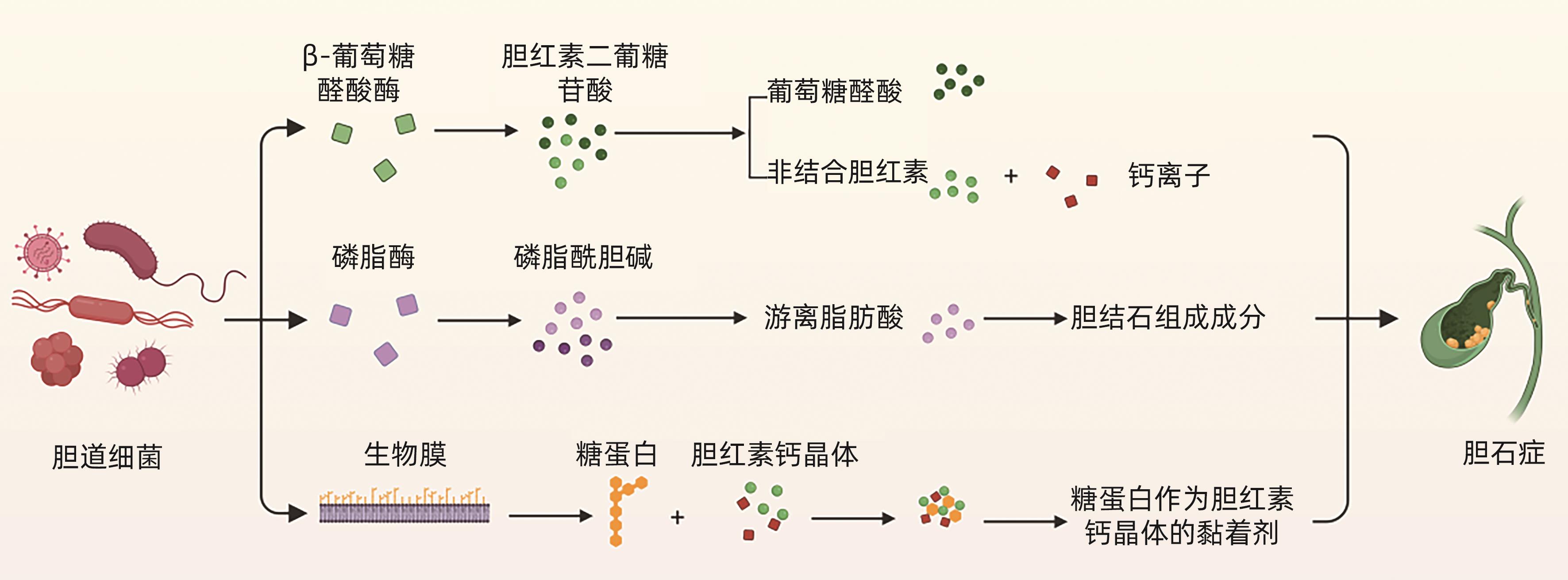胆道微生物群在常见胆道疾病发生发展中的作用
DOI: 10.12449/JCH240831
Role of biliary microbiota in the development and progression of common biliary tract diseases
-
摘要: 胆道微生物群的组成与胆道疾病的发生和发展密切相关。胆道微生物群的失衡可能导致胆结石、胆道感染、自身免疫性胆管炎和胆管癌等一系列胆道疾病的发生。本文整理了胆道微生物群与胆道疾病关系的相关文献并进行综述,总结胆道微生物群对各种胆道疾病的影响,以及胆道中特定菌群在胆道疾病中发挥的作用,以期指导进一步的临床研究,为胆道疾病的预防、诊断、治疗提供新见解。Abstract: The composition of biliary microbiota is closely associated with the development and progression of biliary diseases, and imbalance of biliary microbiota may lead to a series of biliary tract diseases such as gallstones, biliary tract infections, autoimmune cholangitis, and cholangiocarcinoma. This article reviews the articles on the association between biliary microbiota and biliary tract diseases and summarizes the influence of biliary microbiota on various biliary tract diseases and the role of specific bacterial flora in biliary tract diseases, in order to guide further clinical research and provide new ideas for the prevention, diagnosis, and treatment of biliary tract diseases.
-
Key words:
- Gallstones /
- Cholangitis /
- Biliary Tract Infections /
- Cholangiocarcinoma /
- Microbiota
-
肝纤维化作为多种慢性肝病的共同病理过程,其发生机制尚不明确,目前普遍认为肝星状细胞(HSC)活化是其关键环节。正常的肝细胞损伤后,HSC受各种理化因素刺激后转化为肌成纤维细胞,分泌大量的细胞外基质(ECM),ECM产生和降解失衡,肝脏结构重塑,进而导致肝纤维化[1]。晚期肝纤维化通常进展为严重的肝硬化,最终导致肝癌的发生[2]。肝纤维化仍然是全球主要的健康负担,目前尚缺乏有效的抗肝纤维化生物或化学药物,明确肝纤维化的治疗靶点有重要意义[3]。
坏死性凋亡作为一种新型的程序性细胞死亡模式,具有与坏死相似的形态学特征,如细胞变圆和肿胀、线粒体功能障碍、膜电位缺失、细胞膜形成膜孔、完整性丧失,其微观结构为坏死小体,死亡方式为质膜发生爆炸样破裂,并放大周围炎症反应[4]。其发生机制主要与受体相互作用蛋白激酶1(receptor-interacting protein kinase 1,RIPK1)、受体相互作用蛋白激酶3(receptor-interacting protein kinase 3,RIPK3)及底物混合谱系激酶结构域样蛋白(mixed lineage kinase domain-like protein,MLKL)的级联激活密切相关。随着对肝纤维化发病机制探索的不断深入,已有学者证实坏死性凋亡可通过影响肝细胞、HSC、肝巨噬细胞和肝窦内皮细胞的活性与功能,参与多种病因诱发的肝纤维化的发生发展。本文着重阐述坏死性凋亡在肝纤维化中的研究进展,旨在为肝纤维化防治提供新的思路。
1. 坏死性凋亡
坏死性凋亡过程错综复杂,由众多信号分子和蛋白参与,RIPK1和RIPK3在其中发挥关键调控作用,MLKL被磷酸化导致细胞膜受损是其枢纽环节。多种途径参与了坏死性凋亡的激活,其中研究最为广泛的是TNF-α介导的坏死性凋亡信号转导机制。TNF-α受刺激后,肿瘤坏死因子受体1易位至脂质膜,并募集RIPK1、肿瘤坏死因子受体相关死亡结构域(TNF receptor associated death domian,TRADD)、细胞凋亡抑制蛋白1/2和肿瘤坏死因子受体相关因子2,形成复合物Ⅰ[5]。复合物I形成后,在不同信号转导复合物的影响下,决定细胞存亡[6]。
当复合物Ⅰ中的泛素化受到抑制时,其各组分会从细胞膜上释放形成TRADD依赖性复合体(复合体Ⅱa)和RIPK1依赖性复合体(复合体Ⅱb),在复合体Ⅱb形成后,若细胞凋亡受阻或Caspase-8活性受到抑制,则会诱导细胞发生坏死性凋亡。随后,诱导RIPK1的自磷酸化,RIPK3通过其RIP同源相互作用结构域磷酸化,形成关键的坏死体。RIPK1磷酸化会激活RIPK3,RIPK3在T357和S358位点磷酸化MLKL,发生磷酸化后,MLKL寡聚并易位到细胞膜上,导致孔隙形成,损伤相关模式分子(damage associated molecular patterns,DAMP)以及促炎细胞因子释放,最终导致细胞膜破坏后坏死性凋亡的发生,引起组织炎症和器官损伤[8]。
线粒体活性氧(ROS)介导坏死性凋亡的机制包括ROS激活丝氨酸残基161上的RIPK1自磷酸化,以及RIPK3募集形成坏死体。凋亡相关因子(factor-related apoptosis,Fas)是另一种死亡受体,在半胱天冬酶抑制剂存在的情况下,也可通过激活RIPK3和下游MLKL来诱导坏死性凋亡。
2. 坏死性凋亡在肝纤维化中的作用
越来越多的研究表明,坏死性凋亡作为炎症的重要触发因素,在各种肝病的发病过程中发挥不同的作用[9]。一方面,去除RIP3激酶活性可以预防小鼠酒精性肝病的发生并抑制四氯化碳(CCl4)诱导的肝纤维化;另一方面,RIP3降低小鼠在高脂饮食条件下肝损伤的发生[10],MLKL基因敲除小鼠脂肪性肝炎发生率显著降低。此外,不同类型的肝内细胞发生坏死性凋亡,可促进或延缓肝纤维化的进程,发挥双刃剑作用[11-12],总结不同细胞类型的坏死性凋亡与肝纤维化的关系见表1。
表 1 肝内细胞坏死性凋亡与肝纤维化的关系Table 1. Relationship between intrahepatic cell necroptosis and liver fibrosis肝内细胞类型 发生坏死性凋亡后
对肝纤维化的影响
主要作用机制 治疗思路 肝细胞 促进 促进促炎因子DAMP释放,诱导HSC活化 抑制其坏死性凋亡 HSC 抑制 直接抑制HSC活化 靶向促进其发生坏死性凋亡 M1巨噬细胞 抑制 促进促炎因子DAMP释放,诱导HSC活化 靶向促进其发生坏死性凋亡 M2巨噬细胞 促进 吞噬死亡肝细胞,清除促炎因子,抑制HSC活化 抑制其坏死性凋亡 肝窦内皮细胞 促进 调节肝脏内环境能力受损,促进HSC活化 抑制其坏死性凋亡 2.1 不同细胞类型坏死性凋亡与肝纤维化的关系
2.1.1 肝细胞坏死性凋亡
肝细胞死亡被认为是触发肝纤维化的关键因素[13],目前的主要观点认为坏死性凋亡会加剧肝细胞的炎症反应[14],坏死肝细胞释放的DAMP刺激炎症反应的发生,激活HSC,促进肝纤维化发生。基于此,阻止肝细胞发生坏死性凋亡或许能有效避免HSC活化从而延缓肝纤维化的进程。
肝脏坏死性凋亡的发生随着年龄的增长而增加,并且与促炎细胞因子和纤维化标志物表达呈正相关,用坏死性凋亡抑制素1(necrostatin‐1s,Nec‐1s)进行短期治疗,可有效减少坏死性凋亡、促炎细胞因子的表达和老年小鼠的肝纤维化程度[15]。O-连接的β-N-乙酰氨基葡萄糖修饰可防止肝细胞坏死性凋亡和肝纤维化的启动,其机制与RIPK3和MLML的表达增加有关[16]。一种称为SA1009的肝细胞坏死相关DAMP的表达与肝纤维化程度呈正相关[17];非酒精性脂肪性肝病患者外周血中TNF-α和肝组织中RIPK3和MLKL表达明显增加;TNF-α可诱导小鼠原代肝细胞产生更多的ROS,而下调RIPK3可以减少ROS,减轻肝细胞的坏死性凋亡[18]。在小鼠正常肝细胞株AML-12或原代肝细胞中,RIPK小干扰RNA不仅能通过抑制脂质生成基因减少棕榈酸(palmitic acid,PA)诱导的脂质积累,还能减弱PA诱导的氧化应激与炎症反应[19]。MLKL促进肝损伤和肝纤维化,敲除MLKL可减少肝细胞坏死和HSC活化,显著改善CCl4和胆管结扎诱导的肝损伤和肝纤维化,靶向敲除肝细胞中MLKL可能是治疗肝纤维化的有效方法[20]。此外,线粒体未折叠的蛋白质反应可以通过减少细胞氧化应激、维持线粒体正常功能,从而缓解乙醇诱导的肝细胞坏死性凋亡和炎症损伤,延缓肝纤维化进程[21]。
综上,在肝细胞层面,靶向运用坏死性凋亡抑制剂、抑制DAMP活性或者敲除RIPK1、RIPK3及MLKL,减少DAMP引发的炎症反应,从而避免HSC活化,是治疗肝纤维化的有效靶点和途径。
2.1.2 HSC坏死性凋亡
HSC的坏死性凋亡与肝细胞的坏死性凋亡对于肝纤维化的影响不同,HSC坏死性凋亡抑制其本身活化增殖,从而减轻肝纤维化[22]。有趣的是,其他研究[23]发现缺乏MLKL磷酸化和寡聚化的HSC不发生坏死性凋亡,而是通过自噬体和NF-κB途径被激活,MLKL抑制剂可减弱HSC的活化。
活化的HSC对细胞凋亡具有抵抗作用,这种作用主要来自抗凋亡基因Bcl-2,HSC可以在长时间的无血清培养状态,暴露于Fas配体、神经生长因子、TNF-α、多柔比星、依托泊苷和氧化应激介质(如过氧化氢、超氧阴离子和4-羟基壬烯醛)的情况下存活[24],因此,活化的HSC对于坏死性凋亡是否也具有这种抵抗作用值得进一步研究。双氢青蒿素(dihydroartemisinin,DHA)通过剂量依赖降低HSC的活力,这主要是通过促进RIP1、RIP3的表达及MLKL的磷酸化来实现的,进一步研究发现,DHA可能通过激活HSC内Nrt2信号分子来诱导HSC的坏死性凋亡[25]。姜黄素治疗肝纤维化的部分机制是通过诱导HSC坏死性凋亡,清除活化的HSC,该作用与Sirt1/Notch信号通路具有相关性;内质网应激抑制剂4-PBA可预防姜黄醇诱导的坏死性凋亡,提示HSC中内质网应激与坏死性凋亡之间存在潜在联系[26];此外,姜黄醇通过JNK1/2-ROS信号通路,靶向介导HSC坏死,对于肝纤维化的治疗具有潜在价值[22]。
综上,在HSC层面,关注点应集中在如何促进HSC发生坏死性凋亡以减轻ECM沉积。目前缺乏靶向促进HSC坏死性凋亡的化学药物,中草药有效成分在此方面展示了较为满意的效果,如上述姜黄醇和DHA。因此,挖掘靶点明确的促坏死性凋亡药物任重道远。
2.1.3 巨噬细胞坏死性凋亡
巨噬细胞通过产生促炎因子,调节免疫系统稳态,在许多疾病中发挥重要作用。在肝纤维化进程中,M1巨噬细胞促进炎症因子的释放,诱导HSC活化,促进纤维蛋白和ECM形成[27];受损和死亡的肝细胞会被M2巨噬细胞吞噬,坏死肝细胞释放的DAMP、其他有害物质和含有纤维化非编码RNA外泌体的释放也会因此受到抑制,从而减轻肝纤维化[28]。
Kupffer细胞是位于肝脏的巨噬细胞,MLKL对于Kupffer细胞发挥吞噬作用非常重要,缺乏MLKL的Kupffer细胞对生物颗粒的摄取会减少[29]。虽然M2巨噬细胞可通过抑制肝细胞坏死性凋亡,发挥重要的抗炎作用,但目前并没有确切的证据表明Kupffer细胞在肝纤维化期间发生坏死性凋亡。肝纤维化患者的肝组织和肝纤维化模型小鼠中的M1巨噬细胞数量均有所增加,RIP3缺乏可通过ROCK1抑制TLR4→NF-κB信号通路,减少肝脏中巨噬细胞的聚集,从而减轻肝脏炎症和肝纤维化。此外,RIPK3激活应激活化蛋白激酶释放促炎介质(如单细胞趋化蛋白1)后,M1巨噬细胞被募集到受损肝脏处加重肝纤维化[30]。
总之,在肝巨噬细胞层面,暴露于慢性炎症中的M1巨噬细胞吞噬和清扫功能会显著降低,还会增加释放炎性细胞因子的能力,形成恶性循环。Nec-1s减少了炎症反应和M1巨噬细胞聚集,因此Nec-1s的作用靶点可能在于清除衰老细胞,但不能排除其他靶点效应。所以,未来的研究重点在于使用其他抑制坏死性凋亡的药物或RIPK3及MLKL的遗传敲除模型来探讨具体的靶点效应。
2.1.4 肝窦内皮细胞坏死性凋亡
肝窦内皮细胞作为肝脏内主要的非实质细胞,占肝脏细胞总数的15%~20%,是调节肝脏微环境的重要因素。功能失调的肝细胞和内皮细胞主要通过协同作用调节NASH的发生和发展,影响HSC的活化,从而影响肝纤维化的进程[31]。
肝窦内皮细胞可阻止Kupffer细胞和HSC活化,调节肝内血管阻力和门静脉压力,发挥抗炎和抗肝纤维化的作用[32]。在肝损伤以及纤维化发生之前,肝窦内皮细胞就可发生毛细血管化,造成肝细胞与肝血窦之间的物质交换障碍、肝细胞缺氧,加重氧化应激反应和炎症反应[33];特异性敲除肝窦内皮细胞MLKL可抑制TGF-β→Smad 2/3信号通路的激活,破坏肝窦内皮细胞和HSC之间的促纤维化串扰,从而减轻NASH模型小鼠的肝纤维化[34]。
上述研究结果表明,防止正常肝窦内皮细胞发生坏死性凋亡可能是防治肝纤维化的有效策略。
2.2 不同病因肝纤维化中的坏死性凋亡
2.2.1 药物性肝损伤
对乙酰氨基酚(APAP)过量使用会造成明显的肝损伤,主要表现为ALT水平升高,并且会诱导RIP3表达,促进肝纤维化,实验证实Nec-1治疗可有效减轻APAP引起的肝损伤[35]。达拉非尼通过干预RIPK3激酶活性也能起到类似效果[36]。因此靶向阻断坏死性凋亡的发生可能会减轻药物损伤引起的肝纤维化。
2.2.2 酒精性脂肪性肝病
长期乙醇喂养的小鼠肝脏中RIPK3表达明显增加,RIPK3的缺失可有效缓解酒精性肝病引起的肝纤维化[37],但运用Nec-1干预并没有减轻酒精性肝损伤,这表明RIPK可能以独立形式参与酒精性肝病。坏死性凋亡可能通过抑制肝细胞炎症及脂肪变性,减轻酒精引起的肝纤维化。RIPK3特异性抑制剂的研发将有利于促进酒精性脂肪性肝病的防治。
2.2.3 免疫性肝损伤
刀豆蛋白A直接激活T淋巴细胞,通过免疫系统造成肝损伤和肝纤维化。在刀豆蛋白感染肝脏后,RIPK1和MLML蛋白表达增加,而MLML敲除的小鼠肝损伤有所减轻[38]。虽然对于坏死性凋亡在免疫性肝损伤方面的调控机制尚不明确,但其对免疫性肝损伤防治研究具有重要价值。
2.2.4 病毒性肝炎
有研究[39]发现HCV在引起肝细胞死亡时也会诱发其发生坏死性凋亡,但Nec-1治疗并未有效改善肝细胞的坏死性凋亡,未来仍需要更多的研究来探索如何有效利用坏死性凋亡调控病毒性肝炎引起的肝纤维化。其他更多的病因,包括坏死性凋亡在代谢等相关因素影响下造成肝损伤,进而导致肝纤维化的作用机制仍缺乏相应的研究。
3. 总结与展望
综上所述,不同肝内细胞类型的坏死性凋亡在肝纤维化的发生发展进程中起到双刃剑的作用,肝细胞发生坏死性凋亡会加速肝纤维化,M1巨噬细胞中坏死性凋亡因子的缺乏有利于延缓肝纤维化,而诱导活化HSC发生坏死性凋亡则可延缓肝纤维化进程,肝窦内皮细胞坏死性凋亡的研究目前还比较缺乏,但通过抑制坏死性凋亡延缓或者阻止肝窦内皮细胞毛细血管化可能是治疗肝纤维化的有效靶点。许多中药及其活性成分已被证明可以通过多种途径调节肝内细胞的坏死性凋亡,从而起到延缓肝纤维化的作用,这为肝纤维化的治疗开辟了新的途径[40]。另外,其他类型的肝脏细胞与坏死性凋亡之间是否具有相关性,且在不同病因肝纤维化进程中发挥怎样的作用,都需要进一步研究,以利于确定有前景的肝纤维化相关分子靶点,为研发有效的抗肝纤维化药物提供新的思路与方向。
-
[1] SWANSON KS, de VOS WM, MARTENS EC, et al. Effect of fructans, prebiotics and fibres on the human gut microbiome assessed by 16S rRNA-based approaches: A review[J]. Benef Microbes, 2020, 11( 2): 101- 129. DOI: 10.3920/BM2019.0082. [2] LI ZQ, CHU JT, SU FX, et al. Characteristics of bile microbiota in cholelithiasis, perihilar cholangiocarcinoma, distal cholangiocarcinoma, and pancreatic cancer[J]. Am J Transl Res, 2022, 14( 5): 2962- 2971. [3] SINAGRA E, UTZERI E, MORREALE GC, et al. Microbiota-gut-brain axis and its affect inflammatory bowel disease: Pathophysiological concepts and insights for clinicians[J]. World J Clin Cases, 2020, 8( 6): 1013- 1025. DOI: 10.12998/wjcc.v8.i6.1013. [4] NASCIMENTO FSD, SUZUKI MO, TABA JV, et al. Analysis of biliary MICRObiota in hepatoBILIOpancreatic diseases compared to healthy people[MICROBILIO]: Study protocol[J]. PLoS One, 2020, 15( 11): e0242553. DOI: 10.1371/journal.pone.0242553. [5] BOYER JL. Bile formation and secretion[J]. Compr Physiol, 2013, 3( 3): 1035- 1078. DOI: 10.1002/cphy.c120027. [6] CSENDES A, BURDILES P, MALUENDA F, et al. Simultaneous bacteriologic assessment of bile from gallbladder and common bile duct in control subjects and patients with gallstones and common duct stones[J]. Arch Surg, 1996, 131( 4): 389- 394. DOI: 10.1001/archsurg.1996.01430160047008. [7] JIMÉNEZ E, SÁNCHEZ B, FARINA A, et al. Characterization of the bile and gall bladder microbiota of healthy pigs[J]. Microbiologyopen, 2014, 3( 6): 937- 949. DOI: 10.1002/mbo3.218. [8] MOLINERO N, RUIZ L, MILANI C, et al. The human gallbladder microbiome is related to the physiological state and the biliary metabolic profile[J]. Microbiome, 2019, 7( 1): 100. DOI: 10.1186/s40168-019-0712-8. [9] BERG G, RYBAKOVA D, FISCHER D, et al. Correction to: Microbiome definition re-visited: Old concepts and new challenges[J]. Microbiome, 2020, 8( 1): 119. DOI: 10.1186/s40168-020-00905-x. [10] WU T, ZHANG ZG, LIU B, et al. Gut microbiota dysbiosis and bacterial community assembly associated with cholesterol gallstones in large-scale study[J]. BMC Genomics, 2013, 14: 669. DOI: 10.1186/1471-2164-14-669. [11] YE FQ, SHEN HZ, LI Z, et al. Influence of the biliary system on biliary bacteria revealed by bacterial communities of the human biliary and upper digestive tracts[J]. PLoS One, 2016, 11( 3): e0150519. DOI: 10.1371/journal.pone.0150519. [12] SCHNEIDER J, DE WAHA P, HAPFELMEIER A, et al. Risk factors for increased antimicrobial resistance: A retrospective analysis of 309 acute cholangitis episodes[J]. J Antimicrob Chemother, 2014, 69( 2): 519- 525. DOI: 10.1093/jac/dkt373. [13] SUNG JY, COSTERTON JW, SHAFFER EA. Defense system in the biliary tract against bacterial infection[J]. Dig Dis Sci, 1992, 37( 5): 689- 696. DOI: 10.1007/BF01296423. [14] LEE J, PARK JS, BAE J, et al. Bile microbiome in patients with recurrent common bile duct stones and correlation with the duodenal microbiome[J]. Life(Basel), 2022, 12( 10): 1540. DOI: 10.3390/life12101540. [15] KIM MH, MYUNG SJ, SEO DW, et al. Association of periampullary diverticula with primary choledocholithiasis but not with secondary choledocholithiasis[J]. Endoscopy, 1998, 30( 7): 601- 604. DOI: 10.1055/s-2007-1001363. [16] LAI KH, PENG NJ, LO GH, et al. Prediction of recurrent choledocholithiasis by quantitative cholescintigraphy in patients after endoscopic sphincterotomy[J]. Gut, 1997, 41( 3): 399- 403. DOI: 10.1136/gut.41.3.399. [17] CHEN M, WANG L, WANG Y, et al. Risk factor analysis of post-ERCP cholangitis: A single-center experience[J]. Hepatobiliary Pancreat Dis Int, 2018, 17( 1): 55- 58. DOI: 10.1016/j.hbpd.2018.01.002. [18] MAKI T. Pathogenesis of calcium bilirubinate gallstone: Role of E. coli, beta-glucuronidase and coagulation by inorganic ions, polyelectrolytes and agitation[J]. Ann Surg, 1966, 164( 1): 90- 100. DOI: 10.1097/00000658-196607000-00010. [19] TAJEDDIN E, SHERAFAT SJ, MAJIDI MRS, et al. Association of diverse bacterial communities in human bile samples with biliary tract disorders: A survey using culture and polymerase chain reaction-denaturing gradient gel electrophoresis methods[J]. Eur J Clin Microbiol Infect Dis, 2016, 35( 8): 1331- 1339. DOI: 10.1007/s10096-016-2669-x. [20] HUANG D, WAN XJ. Research progress in the formation mechanism of bile duct stones[J]. Adv Clin Med, 2023, 9( 10): 16950- 16959.黄丹, 宛新建. 胆管结石形成机制的研究进展[J]. 临床医学进展, 2023, 9( 10): 16950- 16959. [21] HU FL, CHEN HT, GUO FF, et al. Biliary microbiota and mucin 4 impact the calcification of cholesterol gallstones[J]. Hepatobiliary Pancreat Dis Int, 2021, 20( 1): 61- 66. DOI: 10.1016/j.hbpd.2020.12.002. [22] NOMURA T, SHIRAI Y, HATAKEYAMA K. Enterococcal bactibilia in patients with malignant biliary obstruction[J]. Dig Dis Sci, 2000, 45( 11): 2183- 2186. DOI: 10.1023/a:1026640603312. [23] KIM B, PARK JS, BAE J, et al. Bile microbiota in patients with pigment common bile duct stones[J]. J Korean Med Sci, 2021, 36( 15): e94. DOI: 10.3346/jkms.2021.36.e94. [24] CHOE JW, LEE JM, HYUN JJ, et al. Analysis on microbial profiles& components of bile in patients with recurrent CBD stones after endoscopic CBD stone removal: A preliminary study[J]. J Clin Med, 2021, 10( 15): 3303. DOI: 10.3390/jcm10153303. [25] GUZIOR DV, QUINN RA. Review: Microbial transformations of human bile acids[J]. Microbiome, 2021, 9( 1): 140. DOI: 10.1186/s40168-021-01101-1. [26] BELZER C, KUSTERS JG, KUIPERS EJ, et al. Urease induced calcium precipitation by Helicobacter species may initiate gallstone formation[J]. Gut, 2006, 55( 11): 1678- 1679. DOI: 10.1136/gut.2006.098319. [27] SIPOS P, KRISZTINA H, BLÁZOVICS A, et al. Cholecystitis, gallstones and free radical reactions in human gallbladder[J]. Med Sci Monit, 2001, 7( 1): 84- 88. [28] GRIGOR'EVA IN, ROMANOVA TI. Gallstone disease and microbiome[J]. Microorganisms, 2020, 8( 6): 835. DOI: 10.3390/microorganisms8060835. [29] HAN JY, WU SD, FAN Y, et al. Biliary microbiota in choledocholithiasis and correlation with duodenal microbiota[J]. Front Cell Infect Microbiol, 2021, 11: 625589. DOI: 10.3389/fcimb.2021.625589. [30] LIU J, LIU B, LI HF, et al. Etiological analysis of biliary tract infection[J]. Chin J Nosocomiology, 2018, 28( 20): 3111- 3114. DOI: 10.11816/cn.ni.2018-182836.刘娟, 刘波, 李惠芬, 等. 胆道感染病原学分析[J]. 中华医院感染学杂志, 2018, 28( 20): 3111- 3114. DOI: 10.11816/cn.ni.2018-182836. [31] HU FL, SHANG D, ZHANG HX, et al. A review of Tokyo Guidelines 2018 for the management of acute biliary infections[J]. Chin J Pract Surg, 2018, 38( 7): 763- 766. DOI: 10.19538/j.cjps.issn1005-2208.2018.07.15.胡凤林, 尚东, 张浩翔, 等.《东京指南(2018)》急性胆道感染诊疗策略更新解读[J]. 中国实用外科杂志, 2018, 38( 7): 763- 766. DOI: 10.19538/j.cjps.issn1005-2208.2018.07.15. [32] XIONG GZ, ZHANG JF, DAI XP, et al. Bacterial spectrum and antimicrobial resistance of pathogens from bile culture in patients with biliary tract infection[J]. Chin J Nosocomiology, 2012, 22( 1): 198- 199.熊国祚, 张俊方, 戴先鹏, 等. 胆道感染患者胆汁培养的菌谱调查及耐药性分析[J]. 中华医院感染学杂志, 2012, 22( 1): 198- 199. [33] DALE AP, WOODFORD N. Extra-intestinal pathogenic Escherichia coli(ExPEC): Disease, carriage and clones[J]. J Infect, 2015, 71( 6): 615- 626. DOI: 10.1016/j.jinf.2015.09.009. [34] WU ZY, WU XS, YAO WY, et al. Pathogens' distribution and changes of antimicrobial resistance in the bile of acute biliary tract infection patients[J]. Chin J Surg, 2021, 59( 1): 24- 31. DOI: 10.3760/cma.j.cn112139-20200717-00559.吴自友, 吴向嵩, 姚文衍, 等. 急性胆道感染患者胆汁病原菌分布及耐药率变迁[J]. 中华外科杂志, 2021, 59( 1): 24- 31. DOI: 10.3760/cma.j.cn112139-20200717-00559. [35] China Antimicrobial Resistance Surveillance System. Antimicrobial resistance of bacteria from bile: surveillance report from China Antimicrobial Resistance Surveillance System in 2014-2019[J]. Chin J Infect Contr, 2021, 20( 1): 76- 84. DOI: 10.12138/j.issn.1671-9638.20216177.全国细菌耐药监测网. 全国细菌耐药监测网2014—2019年胆汁细菌耐药监测报告[J]. 中国感染控制杂志, 2021, 20( 1): 76- 84. DOI: 10.12138/j.issn.1671-9638.20216177. [36] MUSSA M, PÉREZ-CRESPO PMM, LOPEZ-CORTES LE, et al. Risk factors and predictive score for bacteremic biliary tract infections due to Enterococcus faecalis and Enterococcus faecium: A multicenter cohort study from the PROBAC project[J]. Microbiol Spectr, 2022, 10( 4): e0005122. DOI: 10.1128/spectrum.00051-22. [37] ZHAO CW, LIU SS, BAI X, et al. A retrospective study on bile culture and antibiotic susceptibility patterns of patients with biliary tract infections[J]. Evid Based Complement Alternat Med, 2022, 2022: 9255444. DOI: 10.1155/2022/9255444. [38] SARCOGNATO S, SACCHI D, GRILLO F, et al. Autoimmune biliary diseases: Primary biliary cholangitis and primary sclerosing cholangitis[J]. Pathologica, 2021, 113( 3): 170- 184. DOI: 10.32074/1591-951X-245. [39] KUMMEN M, THINGHOLM LB, RÜHLEMANN MC, et al. Altered gut microbial metabolism of essential nutrients in primary sclerosing cholangitis[J]. Gastroenterology, 2021, 160( 5): 1784- 1798. DOI: 10.1053/j.gastro.2020.12.058. [40] OLSSON R, BJÖRNSSON E, BÄCKMAN L, et al. Bile duct bacterial isolates in primary sclerosing cholangitis: A study of explanted livers[J]. J Hepatol, 1998, 28( 3): 426- 432. DOI: 10.1016/s0168-8278(98)80316-4. [41] LIWINSKI T, ZENOUZI R, JOHN C, et al. Alterations of the bile microbiome in primary sclerosing cholangitis[J]. Gut, 2020, 69( 4): 665- 672. DOI: 10.1136/gutjnl-2019-318416. [42] HIRAMATSU K, HARADA K, TSUNEYAMA K, et al. Amplification and sequence analysis of partial bacterial 16S ribosomal RNA gene in gallbladder bile from patients with primary biliary cirrhosis[J]. J Hepatol, 2000, 33( 1): 9- 18. DOI: 10.1016/s0168-8278(00)80153-1. [43] CARDINALE V. Classifications and misclassification in cholangiocarcinoma[J]. Liver Int, 2019, 39( 2): 260- 262. DOI: 10.1111/liv.13998. [44] KHAN SA, THOMAS HC, DAVIDSON BR, et al. Cholangiocarcinoma[J]. Lancet, 2005, 366( 9493): 1303- 1314. DOI: 10.1016/s0140-6736(05)67530-7. [45] BRINDLEY PJ, BACHINI M, ILYAS SI, et al. Cholangiocarcinoma[J]. Nat Rev Dis Primers, 2021, 7: 65. DOI: 10.1038/s41572-021-00300-2. [46] PINTO C, GIORDANO DM, MARONI L, et al. Role of inflammation and proinflammatory cytokines in cholangiocyte pathophysiology[J]. Biochim Biophys Acta Mol Basis Dis, 2018, 1864( 4 Pt B): 1270- 1278. DOI: 10.1016/j.bbadis.2017.07.024. [47] KHAN SA, TAVOLARI S, BRANDI G. Cholangiocarcinoma: Epidemiology and risk factors[J]. Liver Int, 2019, 39( Suppl 1): 19- 31. DOI: 10.1111/liv.14095. [48] BARNER-RASMUSSEN N, PUKKALA E, JUSSILA A, et al. Epidemiology, risk of malignancy and patient survival in primary sclerosing cholangitis: A population-based study in Finland[J]. Scand J Gastroenterol, 2020, 55( 1): 74- 81. DOI: 10.1080/00365521.2019.1707277. [49] PEREIRA P, AHO V, AROLA J, et al. Bile microbiota in primary sclerosing cholangitis: Impact on disease progression and development of biliary dysplasia[J]. PLoS One, 2017, 12( 8): e0182924. DOI: 10.1371/journal.pone.0182924. [50] DYSON JK, BEUERS U, JONES DEJ, et al. Primary sclerosing cholangitis[J]. Lancet, 2018, 391( 10139): 2547- 2559. DOI: 10.1016/s0140-6736(18)30300-3. [51] SUTTIPRAPA S, SOTILLO J, SMOUT M, et al. Opisthorchis viverrini proteome and host-parasite interactions[J]. Adv Parasitol, 2018, 102: 45- 72. DOI: 10.1016/bs.apar.2018.06.002. [52] XU T, ZHANG B, ZHOU WC. Research progress on the relationship between biliary flora and cholangiocarcinoma[J]. Chin J Bases Clin Gen Surg, 2021, 28( 3): 404- 408. DOI: 10.7507/1007-9424.202006047.徐涛, 张波, 周文策. 胆道菌群与胆管癌关系的研究进展[J]. 中国普外基础与临床杂志, 2021, 28( 3): 404- 408. DOI: 10.7507/1007-9424.202006047. [53] CHNG KR, CHAN SH, NG AHQ, et al. Tissue microbiome profiling identifies an enrichment of specific enteric bacteria in Opisthorchis viverrini associated cholangiocarcinoma[J]. EBioMedicine, 2016, 8: 195- 202. DOI: 10.1016/j.ebiom.2016.04.034. [54] CHEN BR, FU SW, LU LG, et al. A preliminary study of biliary microbiota in patients with bile duct stones or distal cholangiocarcinoma[J]. Biomed Res Int, 2019, 2019: 1092563. DOI: 10.1155/2019/1092563. -




 PDF下载 ( 1104 KB)
PDF下载 ( 1104 KB)

 下载:
下载:

 下载:
下载:



